- August 4, 2025
- FASHION + SHOPPING
Zoya X Alice Cicolini: Craft, Culture, And Colour in Full Bloom
A bejewelled collaboration five years in the making…
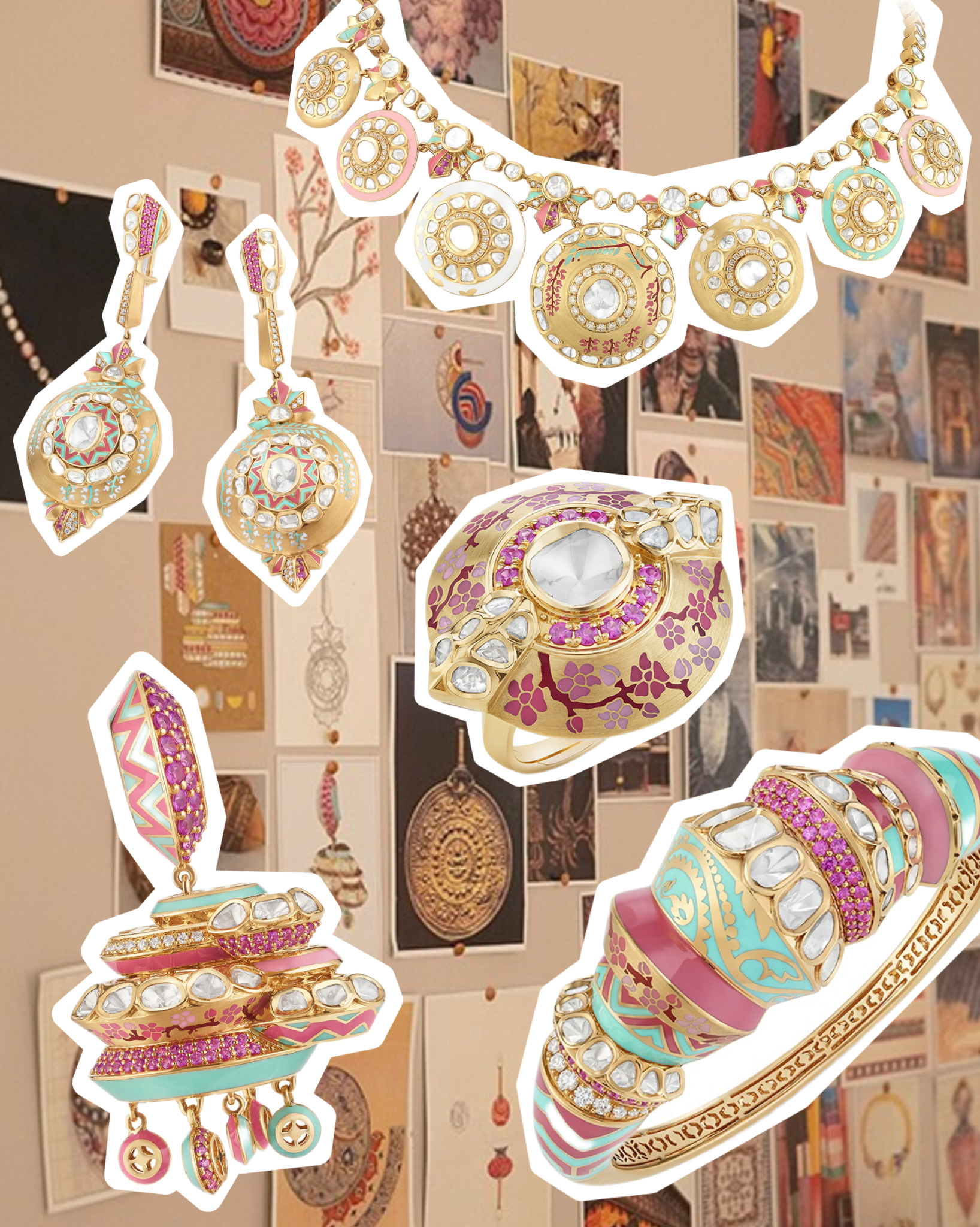
India is undeniably having a moment in global fashion, from mood boards to business strategies. With a wave of East-West collaborations bringing the spotlight on Indian cultural heritage, there’s one partnership that flips the script and stands out as a true embodiment of this zeitgeist – Zoya x Alice Cicolini. This is a first-of-its-kind collaboration in which a leading Indian luxury jewellery atelier, Zoya, has partnered with the acclaimed British designer Alice Cicolini.
Together, they have created a 19-piece capsule collection that redefines Indian jewellery crafts and emblems through a dynamic cultural exchange, blending traditional artistry with contemporary design. Think pastel enamel, sculptural forms, cherry blossoms, chevron, and uncut diamonds set against the metaphorical story of Belgian-French explorer Alexandra David-Néel, the first Western woman to enter Lhasa, guided by integrity, wonder, and passion.
Featuring reinterpretations of jhumkas, kadas, and bali among others and brought to form with 18kt satin-soft gold, uncut diamonds, and intricate enamel, this collection has a deeply feminine and wondrous soul expressed with a palette of sage green, rose blush, and dew cream and blended with storytelling, craft, and cultural symbolism. For instance, Layered Facets Jhumki, inspired by the sacred architecture of Lhasa, is a sculptural reimagination of a jhumka with cut and uncut diamonds, pink sapphires, and enamelled cherry blossoms and chevron. Resonant Echoes Necklace, inspired by ceremonial gongs and heirloom Indian forms, blends uncut diamonds, soft enamel tones, and delicate cherry blossoms with sculpted symmetry and the grace of sacred sound and movement. Woven Lattice Bangle shaped by the layered facades of Lhasa’s hills, with uncut diamonds, pink sapphires, and pastel enamelled details.
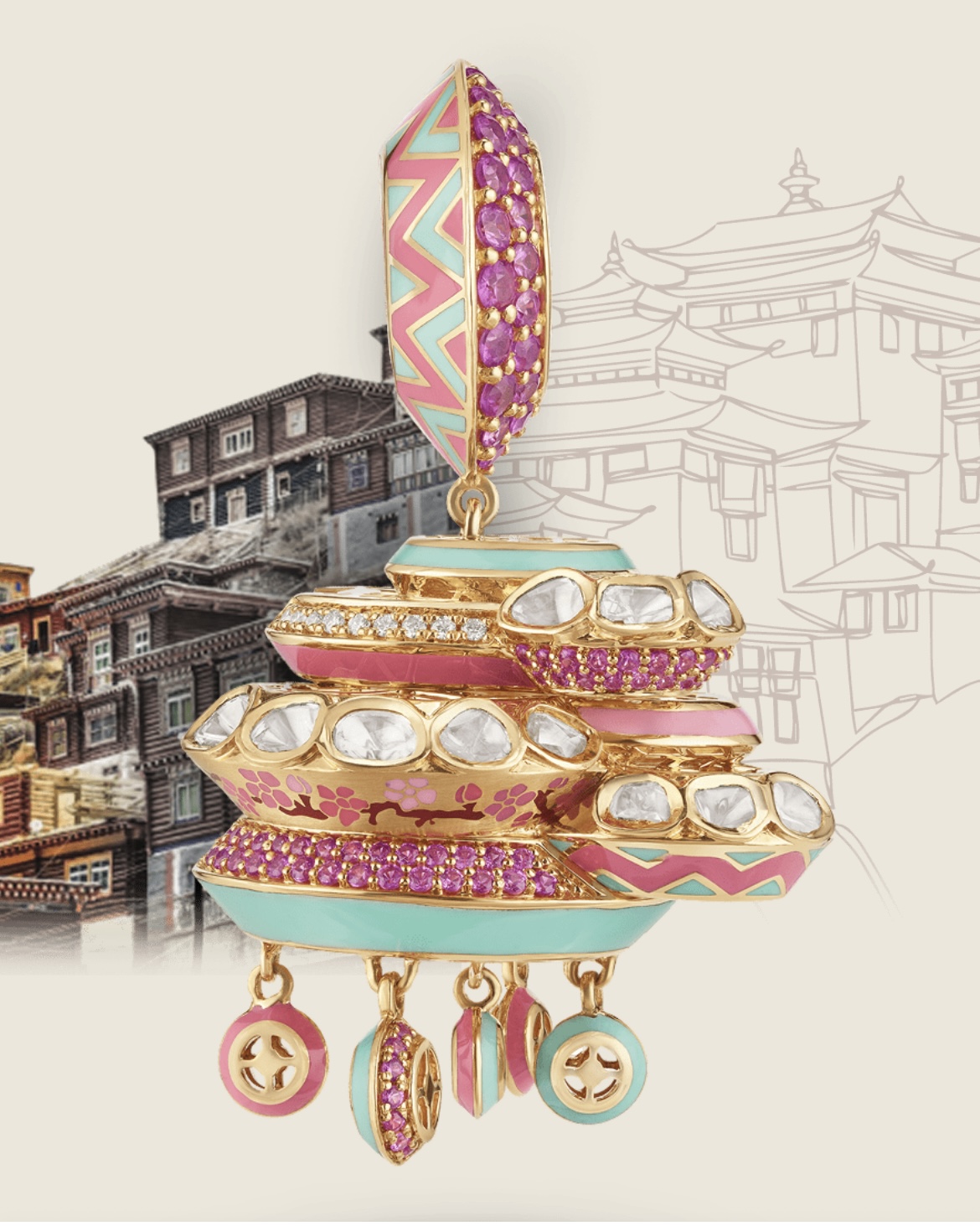
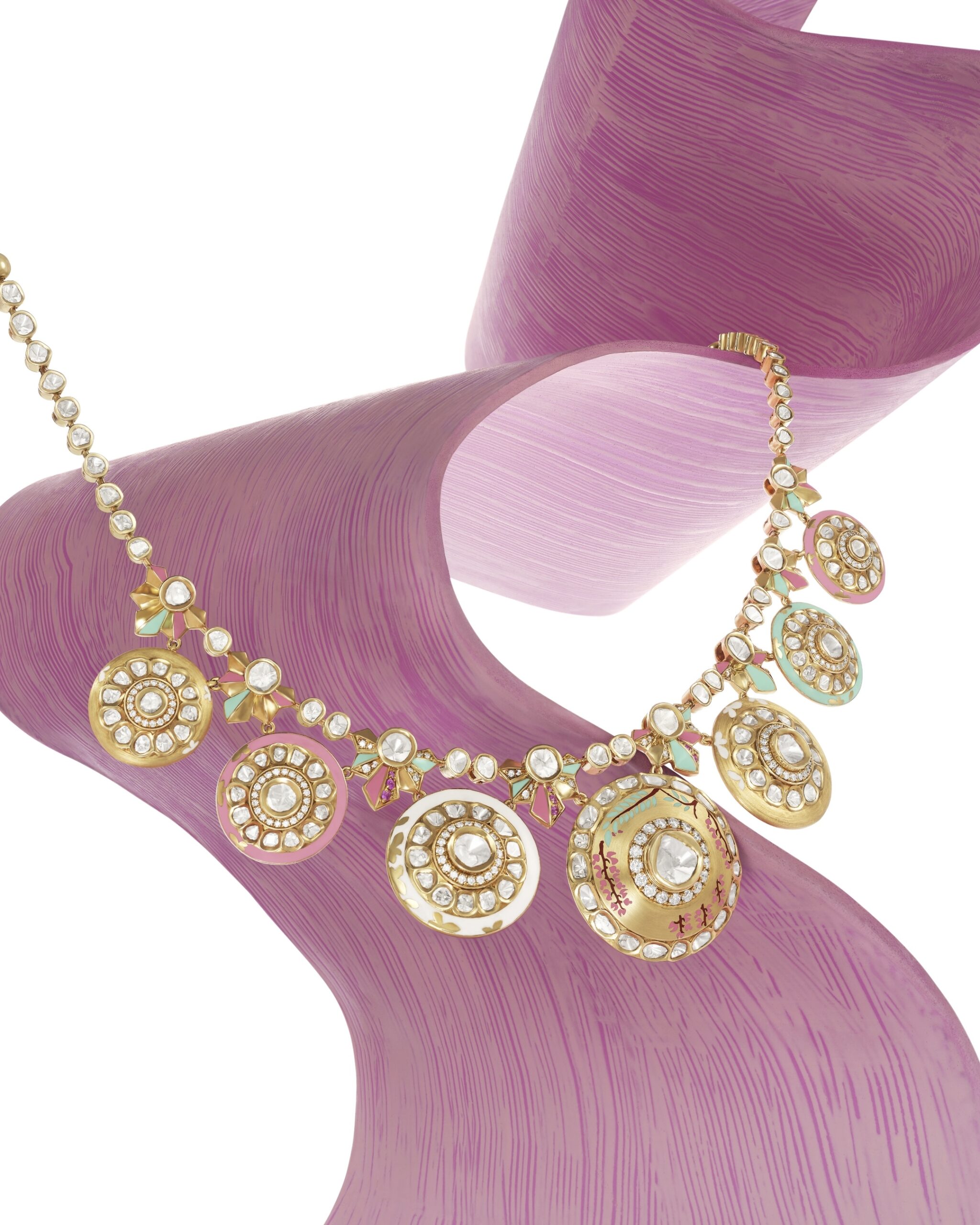
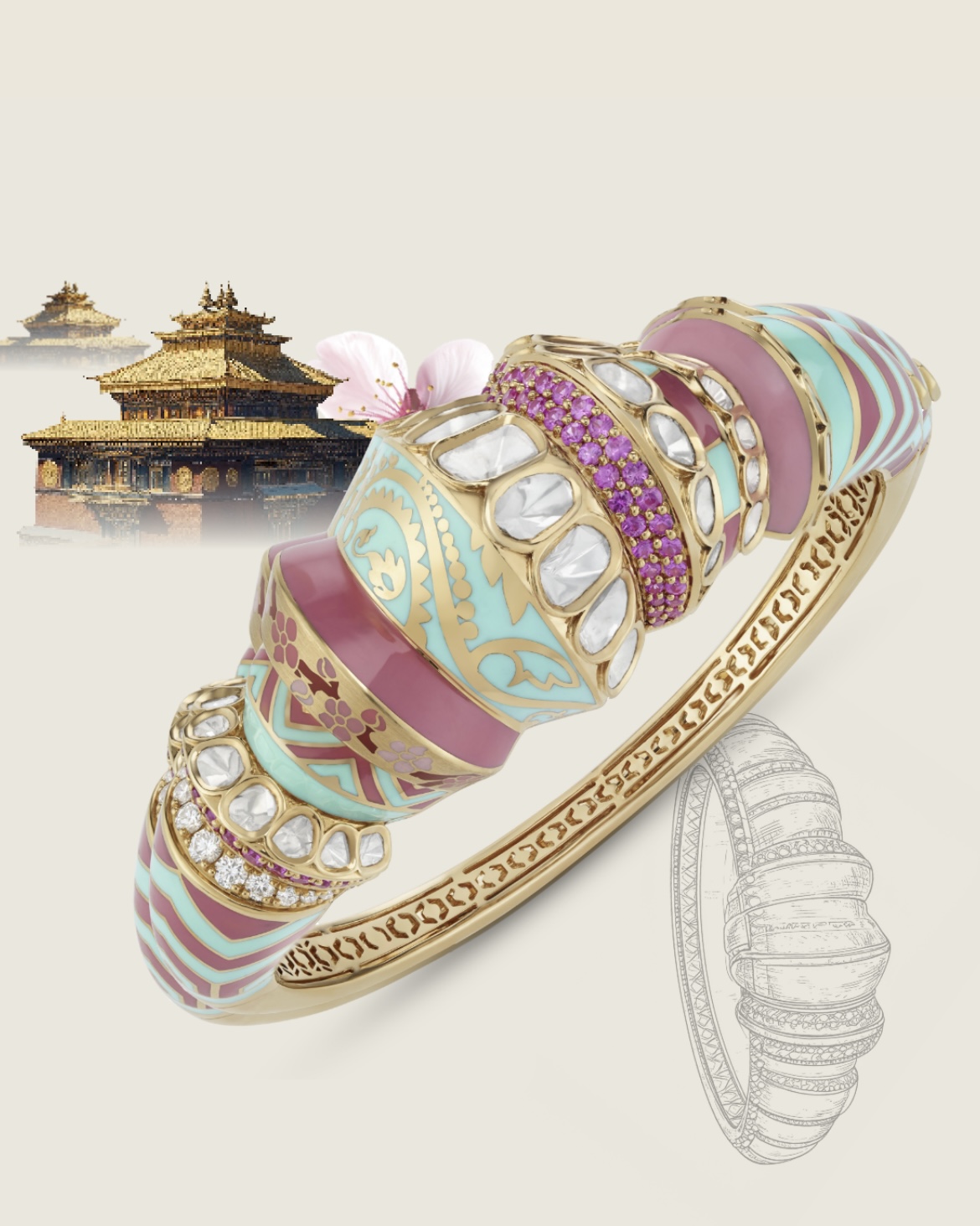
(L-R) Layered Facets Jhumki, Resonant Echoes Necklace, and Woven Lattice Bangle
Five years in the making, this creative partnership is more than a meeting of aesthetics; it’s a shared dialogue between Indian craftsmanship, cultural memory, and soulful storytelling. And here, in a conversation with Runway Square’s Junior Editor – Karishma Gulyani, Alice Cicolini and Revathi Kant (Chief Design Officer, Titan Company) elaborate on their narrative-led design approach with the stories of craft and colour, softness and structure, poetry and precision
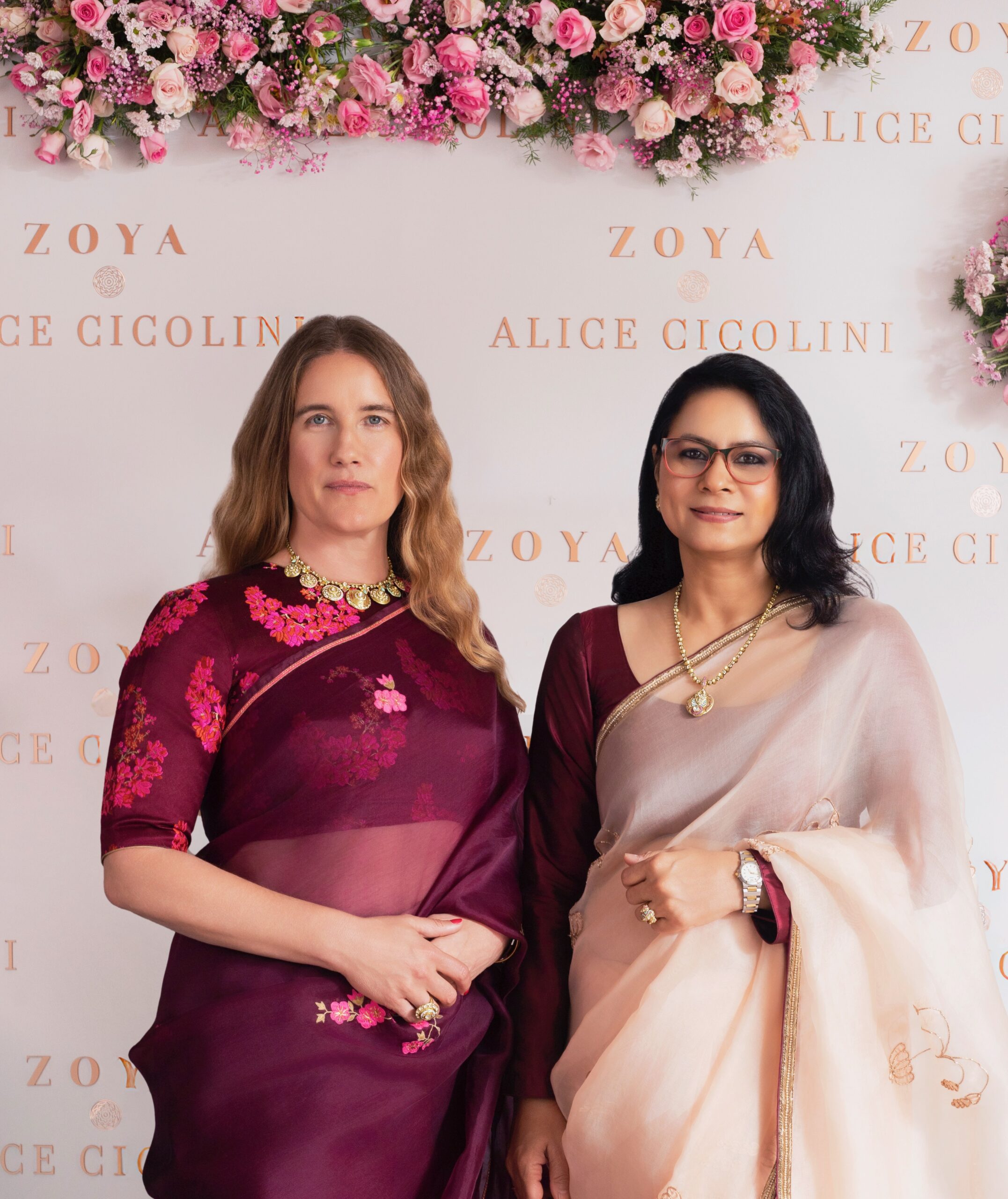
Alice Cicolini and Revathi Kant
Runway Square: How did this collaboration evolve from thought to design over the five years?
Alice Cicolini: When they first connected with me, it felt like an exciting opportunity to explore a collaboration with a luxury Indian jewellery house because Zoya (and TATA) have very similar values to mine. Like me, they’re super-focused on the design-led approach and are always looking to innovate and move the jewellery segment forward with stories and techniques. And then, as Revathi and I spent a lot of time connecting, we realised that we share a strong passion for master craftsmanship and a deep belief in the importance of cultural heritage.
We started with a brief for an enamel collection and to use uncut diamonds in a rather distinctive setting. Although five years for a collection development isn’t unusual for European luxury businesses, I understand this is quite unusual for an Indian luxury business. Even though there was COVID in the middle that slowed things down, we continued with the design development, discussed the enamel techniques we were going to use, and experimented with different approaches. We also researched new ways to set the diamonds so that they were sturdier yet aesthetically respected the Kundan Meena traditions – along with experimenting with gold to remove the weight, so that the pieces would be both striking and bold in their scale yet wearable. So, over these five years, there was a lot of energy that we put into the technological development around this collection, which makes it innovative from a production as well as a design perspective.
RSQ: This collection is an intimate interpretation of Alexandra David-Néel and her journey. What inspired you to choose her as your muse for this collection?
AC: The idea that we share cultures and motifs across continents has been the foundation of my collections since I started designing jewellery. And for this collaboration with Zoya, I wanted to create something beyond my usual design language. Given that Zoya and I both prefer a narrative-led design approach, I thought, let’s try and tell this story from a different perspective, as Zoya always talks about the heroine’s journey and how the Zoya woman is at the core of their design practice. It prompted me to think, who is the Zoya woman in the context of this collaboration? And this inspired me to delve into the story of Alexandra David-Néel.
During her 16-year journey around the world, Alexandra travelled up the Eastern coast of India and spent 5 years in Lhasa as the first woman to be invited into the Dalai Lama’s palace. Well, she wasn’t invited because she was vaguely interested in the culture. She was invited for her profound knowledge, passion, authenticity, and integrity as a person who aligned with the spiritual path. Her dedication to learning and self-discovery across cultures and continents resonated with me and became the heart of this collection’s narrative.
RSQ: How did Lhasa’s cultural and architectural elements influence your design process for the collection?
AC: The design inspiration comes from Lhasa because that’s where Alexandra David-Néel ends up for a prominent part of her journey. And the Tibetan architecture, with its fearless explorations of pattern and geometry, truly captivated me. They have all these stratified layers along with bold geometric and decorative patterns. And since my design language is about pattern and colour and their exuberant combination, it was quite a captivating story and destination to start the design process. With my designs being a balance of simple and bold forms, I drew inspiration from the architecture, not just for patterns, but also to give a sculptural form to the pieces.
From gongs to temple scrolls, I drew inspiration from these, not just as objects to elevate but as cultural emblems to celebrate. Through this collection, we have highlighted the powerful poetry woven into their form and sound – while bringing forward the surreal, symbolic depth they hold within Lhasa’s cultural heritage.
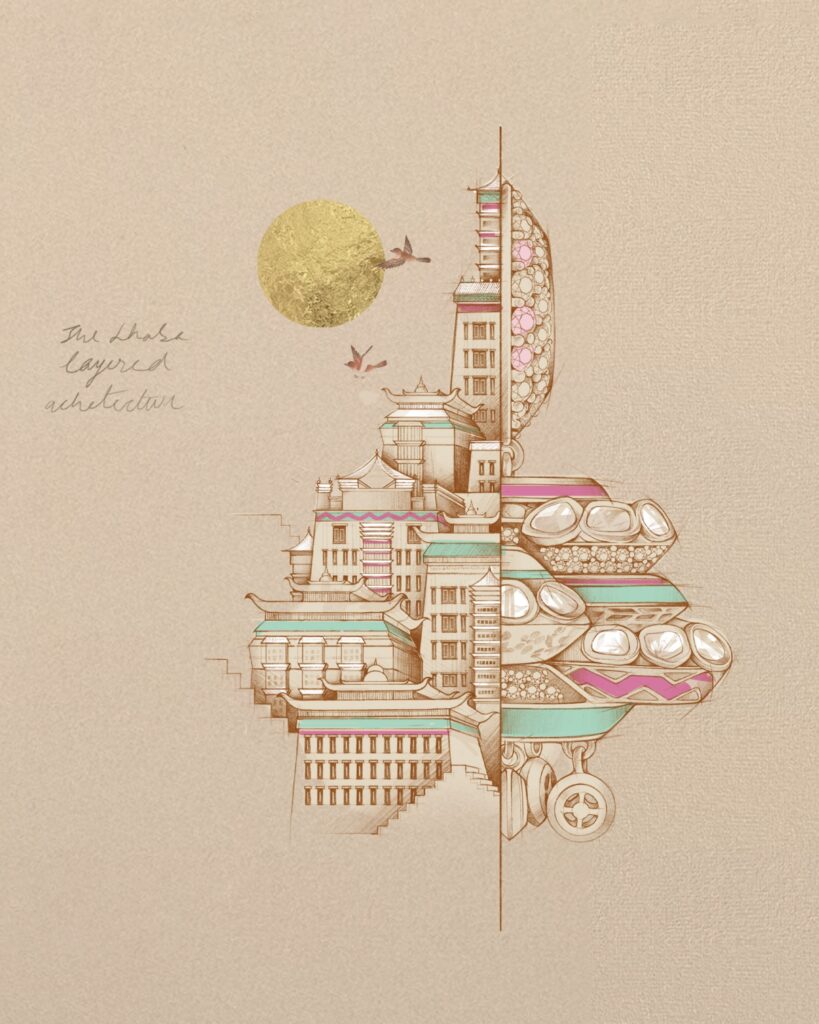
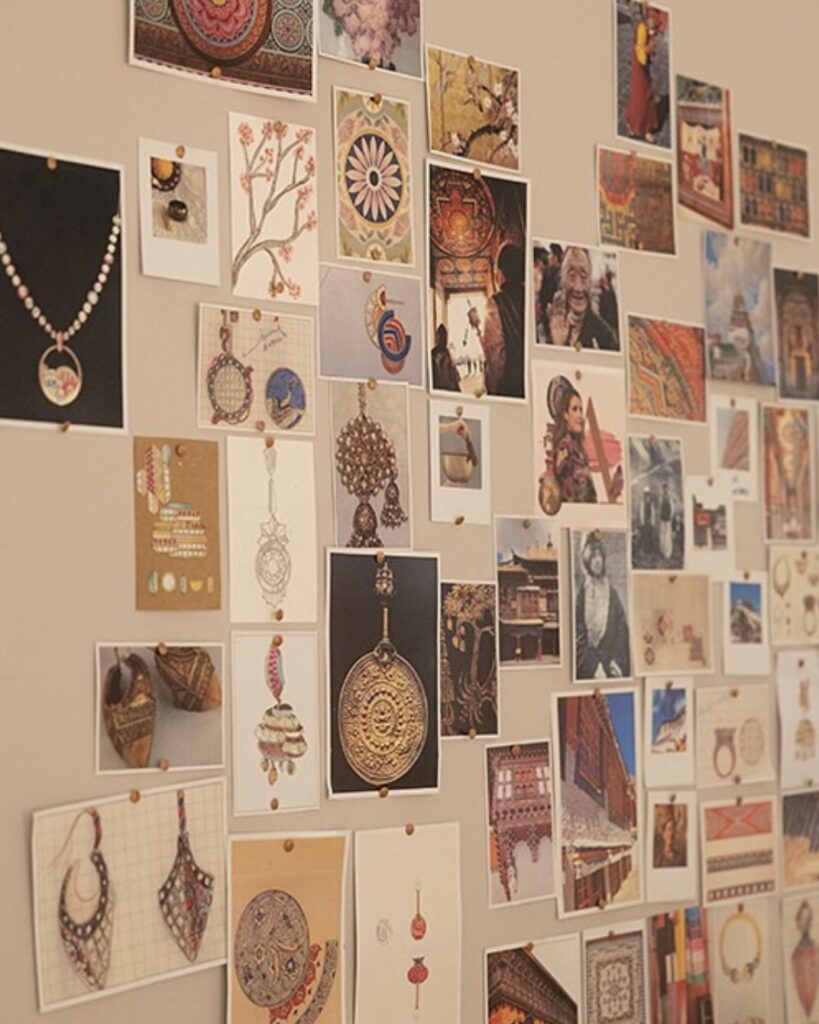
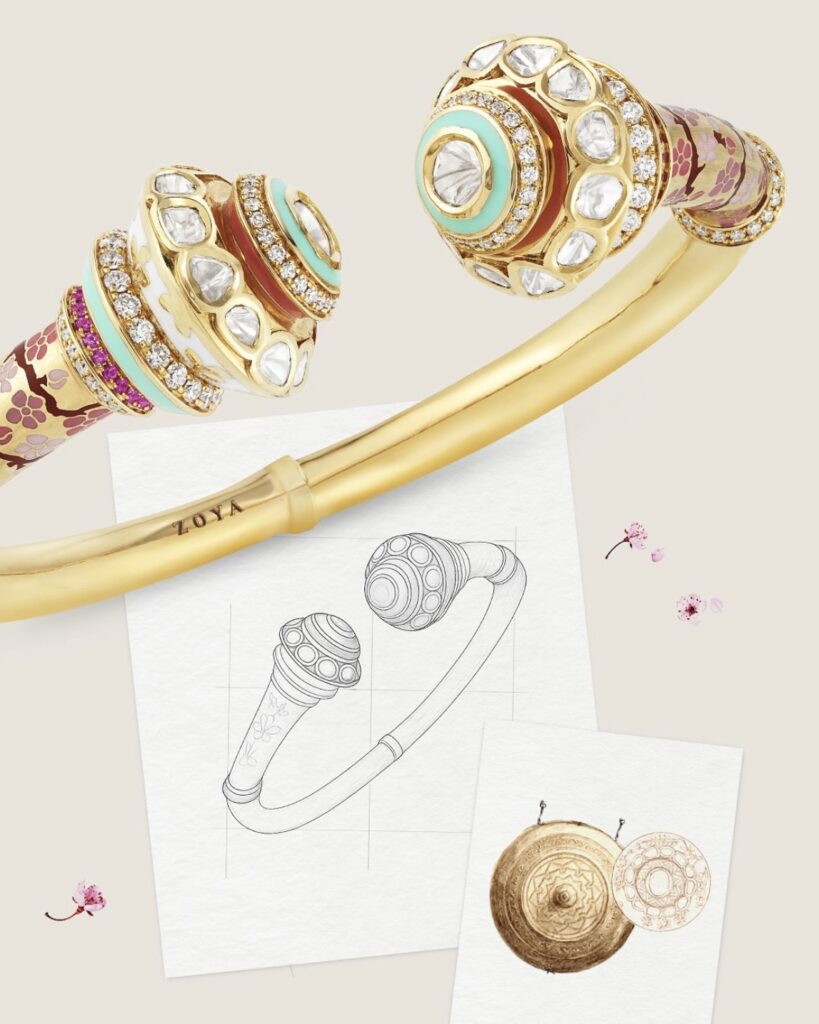
Moodboard For Zoya X Alice Cicolini
RSQ: Enamel is the technique that binds this collaboration together. How has it been celebrated with distinction?
Revathi Kant: Enamel, considered one of India’s most poetic art forms, takes centre stage in this limited-edition collection. With a delicate palette – sage green, rose blush, and dew cream – woven through motifs like cherry blossoms and chevron patterns, the enamel craftsmanship is intricate and deeply respectful of tradition, yet feels fresh and instinctively playful. It brings a quiet power and lyrical quality to every piece.
AC: As we were looking to produce a collection for everyday wear, we turned to cold enamel technique for its versatility and strength. One of the great beauties of Meenakari is that it is glass, but it’s also one of its core fragilities. And I find that a woman who buys jewellery for herself nowadays wants to buy something that she can make part of her daily life, which prompted us to prioritize cold enamel for its durability and vibrant charm. Though it’s traditionally seen as a lesser craft compared to Meenakari, I don’t believe that – rather, I think it has many strengths of its own, like the easy mix and use of colours to create more striking designs. It too demands the skill of master craftsmen to work with it properly and with sensitivity. And to sustain enamel as a living tradition, cold enamel plays an important role, offering accessibility without sacrificing artistry.
RSQ: Rings to jhumkas, bangles to necklaces, how have you incorporated your signature design language into this collaboration?
AC: Well, there are a few signature giveaways. I’ve used the chevron extensively in this collection, which is one of the core elements of my design language. It’s one of the earliest human markings and the symbol of water and Aquarius. But it’s also very much connected to Rajasthani tiles, which I find so beautiful, making it one of the most powerful and uniting patterns. Though I usually use it in black and gold or black and white, here we have used it in pastel tones of the collection. I have always been all about playing with colour and doing it in a really complex way, and I’ve extended that playfulness with colour into this collection as well.
Every piece has colours especially mixed for it. And these aren’t factory-available colours or the classic Indian enamel colours from Jaipur or Banaras. I always want the palette to be unique to the collection and the story. It has always been one of the ways that I’ve brought distinctiveness into my work with enamel in India. I’m always looking to expand that colour palette beyond traditional colour territories. Zoya and I were very excited to manifest this palette, as it was intriguing to put together a palette that was quite different from what you usually find in Indian jewellery. This is a soft and feminine palette that spotlights the narrative of freshness and rebirth – after all, dew cream, rose blush, and soft sage are all spring abundance colours. This colour palette also highlights the technical skill involved in the collection, especially in mixing and matching colours repeatedly yet uniquely for each design. Like Josef Albers (20th-century abstract painter and educator) said, it is easy to work with two colours, but to work with four – now that’s really complicated. And I think it’s always been part of my design approach to do things that look simple and effortless, but are quite complicated in reality.
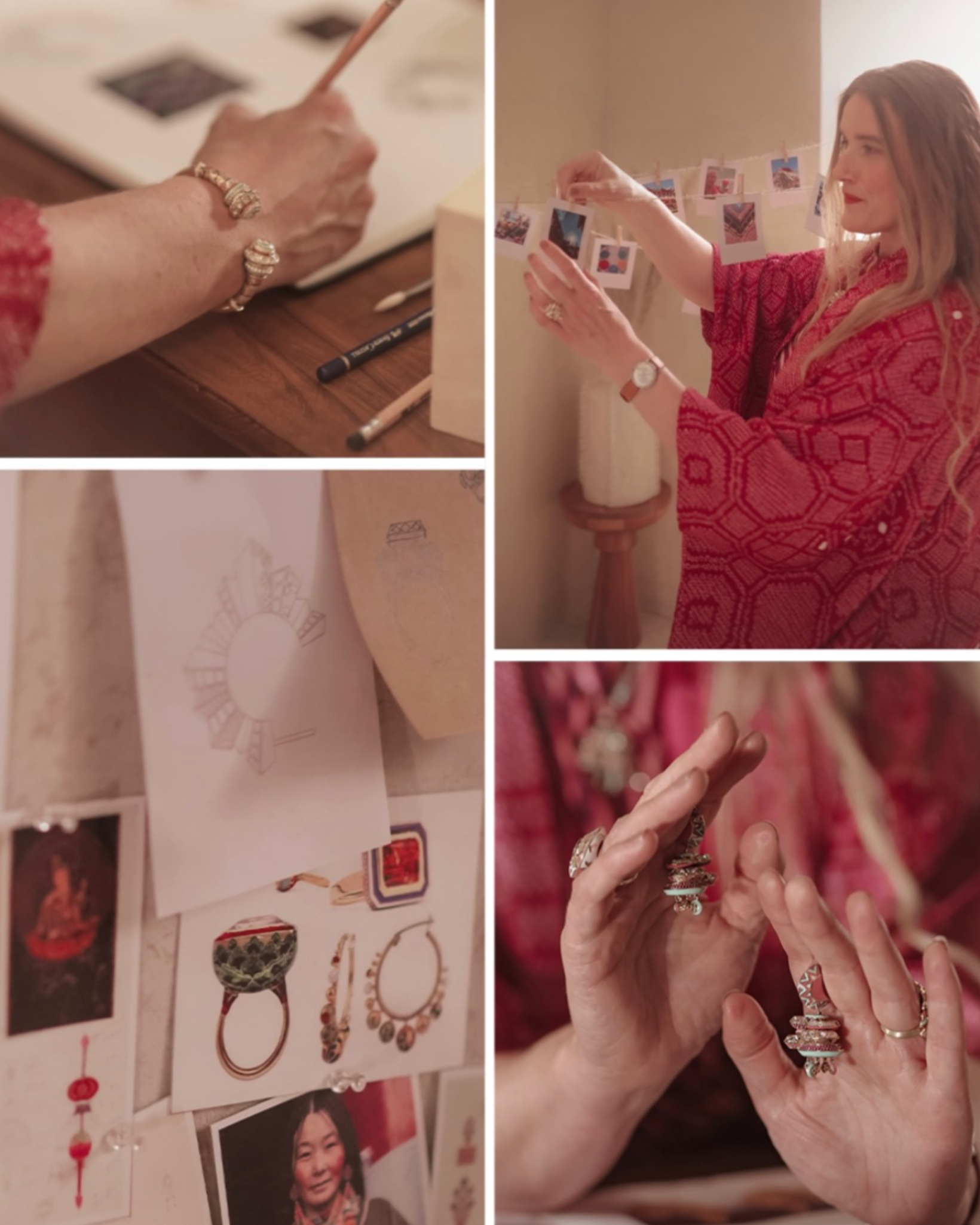
Layers of Memory Bangle and Layered Facets Jhumki from Zoya X Alice Cicolini
RSQ: Having reinterpreted jhumkas, kadas, and other traditional Indian jewellery styles with a balance of softness and structure, what are your thoughts behind the reinterpretation?
RK: The reinterpretation is rooted in an architectural approach to refine the classic Indian styles, like bali and jhumkas, into a sculptural and contemporary design. The reinterpreted jewels still carry a timeless vibe, almost as if they have travelled across eras yet remain entirely relevant to the present moment. It’s a nod to heritage, elevated through thoughtful design.
AC: The jhumkas are such a traditional Indian shape and still so enduringly popular, and so are those bangle forms and the rhythmic circular necklaces. When you’re presenting a design where there’s a familiarity or an emotional connection in the form, then people tend to find it fascinating when they see that particular shape transformed into something new and fresh. So, it was really an underlying thought to understand the traditional forms that would draw you in with beauty and emotion, while their transformation brings out the fun and excitement.
RSQ: Besides Alexandra David-Néel, who do you think embodies the essence of the collection?
RK: The spirit of the collection is embodied by a woman who wanders freely between worlds, carrying within her the elegance of tradition and the boldness of modernity. She’s contemplative, creative, and unafraid to travel deeply within.
These sculptural silhouettes, layered with meaning and feminine energy, are created for her to make her feel alive and seen.
AC: I was just telling Revathi today that she is the Zoya woman, as someone who’s achieved so much in her life yet remains deeply self-reflective and committed to her inner journey. And honestly, I feel like a Zoya woman. Alexandra inspires me as an adventurer, a traveller, and someone who embraces other cultures with genuine integrity. As a young girl, I was really captivated by cultural heritage and objects, often visiting the British Museum with my mother. Even then, I felt the world was brimming with wonder and beauty.
RSQ: This is a defining moment for East-West collaborations. What is the X-factor behind this collaboration that makes it stand out?
AC: I think what’s particularly interesting about this collaboration is that rather than a big international brand hiring an Indian designer, we have an Indian luxury brand hiring an international designer to come in and do a collaborative project. And I do believe it is a recognition of my work and association with the craft and culture of India. I’ve been coming to India for 26 years and working closely with the design community here, first as a curator and now as a designer. There is a degree of seriousness and respect in my connection with the subcontinent that I think Zoya recognized. And though I’m emotionally invested in the craft traditions, I have the advantage of operating in an international context with a different perspective on the same motifs and craft.
RK: This collaboration is a natural extension of Zoya’s journey, rooted deeply in India’s rich craft heritage. In Alice, we found a true creative partner. Her work, which traces motifs across cultures and thoughtfully weaves patterns from different geographies and eras, resonated deeply with Zoya’s design-first philosophy – along with her instinctive yet respectful approach to enamel that aligned seamlessly with our own. Together, we’ve created a capsule collection richly layered with story, structure, and soul.
All Images Courtesy of Zoya
Karishma is a science nerd turned fashion and beauty writer who loves talking about trends as much as eating desserts. Gucci, salted caramel ice-cream, jewels, and Simba (her dog) make up four chambers of her heart. Like Karishma’s story? Drop her a line in the comments section below.


